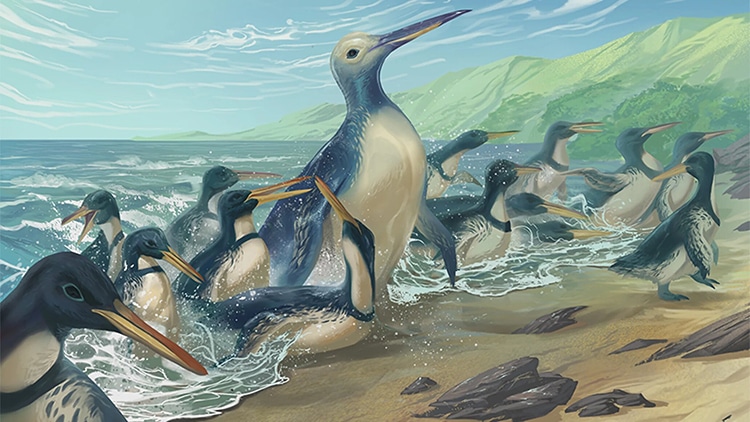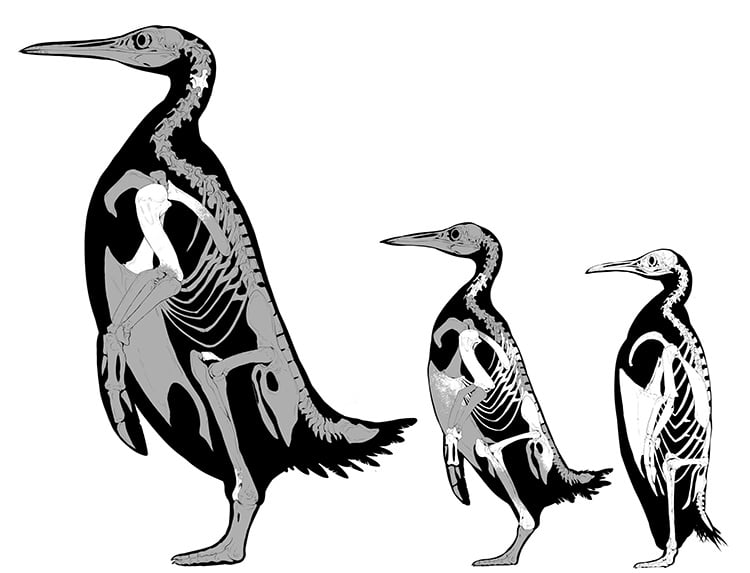
Artist reconstructions of Kumimanu fordycei and Petradyptes stonehousei. (Photo: Simone Giovanardi)
Penguins are fascinating creatures. They come in a variety of sizes, live in diverse habitats, and are undeniably adorable. The penguin species of the past were no less interesting. A recent paper in the Journal of Paleontology has announced the discovery of the biggest ancient penguin yet, a 340-pound behemoth that frolicked around New Zealand more than 50 million years ago. Newly named Kumimanu fordycei, the giant species was discovered alongside several other ancient skeletons of seabirds inside boulders along the seashore.
The enormous species was discovered by Alan Tennyson, a paleontologist at the Museum of New Zealand Te Papa Tongarewa, in seaside boulders which had split open. Excavations revealed the K. fordycei fossil among a flock of five Petradyptes stonehousei, another new species. A specimen of Kumimanu biceae, a previously discovered giant penguin species, and the bones of smaller unnamed species were also discovered. Tennyson and his team scanned the bones with lasers to compare their flipper sizes with those of other flying and diving birds. Flipper size allowed for the estimation of the birds’ sizes.
The magnificent K. fordycei has set a new record; the previous title was held by the 256-pound Palaeeudyptes klekowskii, a species found about 37 million years ago in Antarctica. The other new species discovered in New Zealand is also quite large, although at 110 pounds it is not much larger than an average modern Emperor penguin.
K. fordycei‘s massive size came at an interesting time in penguin evolution. Around 60 million years ago, penguins lost their ability to fly. Their body mass kept them warm in cold seas, while it also made them relatively impervious to predators. The asteroid impact, which caused the excitation of the dinosaurs, also killed off many marine predators.
“Size conveys many advantages,” first author of the paper, Dr. Daniel Ksepka, said in a statement. “A bigger penguin could capture larger prey, and more importantly it would have been better at conserving body temperature in cold waters. It is possible breaking the 100 lb size barrier allowed the earliest penguins to spread from New Zealand to other parts of the world.”
“Kumimanu fordycei would have been an utterly astonishing sight on the beaches of New Zealand 57 million years ago, and the combination of its sheer size and the incomplete nature of its fossil remains makes it one of the most intriguing fossil birds ever found,” co-author Dr. Daniel Field from Cambridge, said. “Hopefully future fossil discoveries will shed more light on the biology of this amazing early penguin.”
Paleontologists discovered the fossils of a 340-pound giant penguin species that frolicked around New Zealand more than 50 million years ago.

Skeletons of Kumimanu fordycei, Petradyptes stonehousei, and a modern emperor penguin. (Photo: Simone Giovanardi)
h/t: [Smithsonian Magazine]
Related Articles:
Man Finds 82-Foot-Long Dinosaur Fossil in His Backyard
“De-Extinction” Biotech Company Is Working To Bring the Dodo Back To Life
Fossil of Ancient Giant Sea Turtle the Size of a Rhino Discovered in Spain
66-Million-Year-Old Fossilized Dinosaur Egg Discovered With Baby Inside
